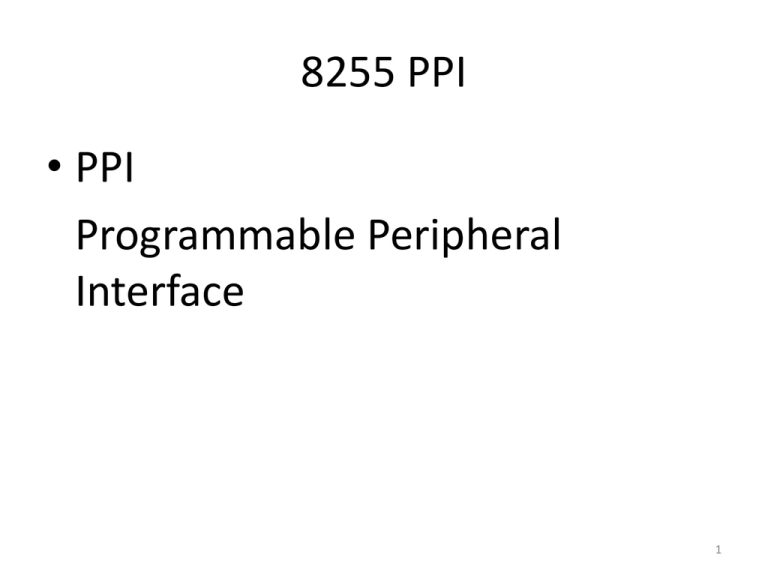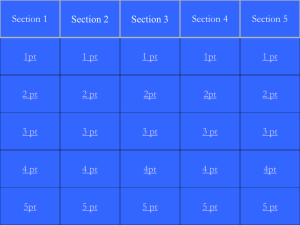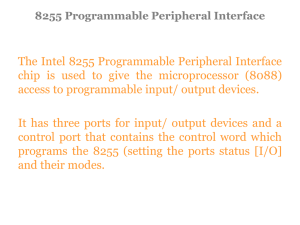File
advertisement

8255 PPI • PPI Programmable Peripheral Interface 1 Intel 8255 PPI PPI – Programmable Peripheral Interface It is an I/O port chip used for interfacing I/O devices with microprocessor Very commonly used peripheral chip Knowledge of 8255 essential for students in the Microprocessors lab for Interfacing experiments 2 About 82C55 • The 82C55 is a popular interfacing component, that can interface any TTL-compatible I/O device to a microprocessor. • It is used to interface to the keyboard and a parallel printer port in PCs (usually as part of an integrated chipset). • Requires insertion of wait states if used with a microprocessor using higher that an 8 MHz clock. • PPI has 24 pins for I/O that are programmable in groups of 12 pins and has three distinct modes of operation. 82C55 : Pin Layout 8255 Control Word Basic Mode Definitions and Bus Int • Mode 0 – Basic I/O • Mode 1 – Strobe I/O • Mode 2 – Bi-Dir Bus Programming 8255 8255 has three operation modes: mode 0, mode 1, and mode 2 11-7 8 8255 PPI contd. 3 ports in 8255 from user’s point of view - Port A, Port B and Port C. Port C composed of two independent 4-bit ports - PC7-4 (PC Upper) and PC3-0 (PC Lower) A1 A0 Selected port 0 0 Port A 0 1 Port B 1 0 Port C 1 1 Control port 9 8255 Intel 8255 PPI Vcc (+5V) PA7-0 GND Chip Select Circuit WR 1 2 7404 1 U1 2 3 4 CS 8 U3A 1 2 D7-0 5 6 11 12 M/IO* PC7-4 Port C PC3-0 Control Port PB7-0 7430 7404 Port A RD U2A A7 40 pin DIP A1 Port B A0 Reset A7=0, A6=1, A5=1, A4=1, A3=1, A2=1, & M/IO*= 0 10 8255 PPI Contd. There is also a Control port from the Processor point of view. Its contents decides the working of 8255. When CS (Chip select) is 0, 8255 is selected for communication by the processor. The chip select circuit connected to the CS pin assigns addresses to the ports of 8255. For the chip select circuit shown, the chip is selected when A7=0, A6=1, A5=1, A4=1, A3=1, A2=1, & M/IO*= 0 Port A, Port B, Port C and Control port will have the addresses as 7CH, 7DH, 7EH, and 7FH respectively. 11 8255 PPI Contd. Mode 0: Simple Input or Output In this mode, ports A, B are used as two simple 8-bit I/O ports port C as two 4-bit ports. Each port can be programmed to function as simply an input port or an output port. The input/output features in Mode 0 are as follows. 1. Outputs are latched. 2. Inputs are not latched. 3. Ports don’t have handshake or interrupt capability. 12 8255 PPI Contd. Mode 1: Input or Output with Handshake In this mode, handshake signals are exchanged between the MPU and peripherals prior to data transfer. The features of the mode include the following: 1. Two ports (A and B) function as 8-bit I/O ports. They can be configured as either as input or output ports. 2. Each port uses three lines from ort C as handshake signals. The remaining two lines of Port C can be used for simple I/O operations. 3. Input and Output data are latched. 4. Interrupt logic is supported. 13 8255 PPI Contd. Mode 2: Bidirectional Data Transfer This mode is used primarily in applications such as data transfer between two computers. In this mode, Port A can be configured as the bidirectional port Port B either in Mode 0 or Mode 1. Port A uses five signals from Port C as handshake signals for data transfer. The remaining three signals from port C can be used either as simple I/O or as handshake for port B. 14 8255 Handshake signals Where are the Handshake signals? Port C pins act as handshake signals, when Port A and Port B are configured for other than Mode 0. Port A in Mode 2 and Port B in Mode 1 is possible, as it needs only 5+3 = 8 handshake signals After Reset of 8255, Port A , Port B , and Port C are configured for Mode 0 operation as input ports. 15 8255 Handshake signals Contd. PC2-0 are used as handshake signals by Port B when configured in Mode 1. This is immaterial whether Port B is configured as i/p or o/p port. PC5-3 are used as handshake signals by Port A when configured as i/p port in Mode 1. PC7,6,3 are used as handshake signals by Port A when configured as o/p port in Mode 1. PC7-3 are used as handshake signals by Port A when configured in Mode 2. 16 8255 PPI Contd. Port A can work in Mode 0, Mode 1, or Mode 2 Port B can work in Mode 0, or Mode 1 Port C can work in Mode 0 only, if at all Port A, Port B and Port C can work in Mode 0 Port A and Port B can work in Mode 1 Only Port A can work in Mode 2 17 8255 MD Control word Control port having Mode Definition (MD) control word 1 M2A M1A I/P A I/P CU M1B I/P B I/P CL Means Mode 1 - PCU as input 1 -PCL as input Definition 0 - PCU as output 0 -PCL as output control word 1 - PA as input 1 - PB as input M2A M1A 0 - PA as output 0 - PB as output 1 – Port B in Mode 1 0 0 Port A in Mode 0 0 – Port B in Mode 0 0 1 Port A in Mode 1 1 0/1 Port A in Mode 2 18 8255 MD Control word Contd. Ex. 1: Configure Port A as i/p in Mode 0, Port B as o/p in mode 0, Port C (Lower) as o/p and Port C (Upper) as i/p ports. Required MD control word: 1 0 0 1 1 0 0 0 = 98H MD control PC Lower as o/p PA in Mode 0 PB as o/p Reqd. instrns. PA as i/p PB in Mode 0 MOV AL, 98H PC Upper as i/p OUT 7FH, AL 19 8255 MD Control word Contd. Ex. 2: Configure Port A as i/p in Mode 1, Port B as o/p in mode 1, Port C7-8 as i/p ports. (PC5-0 are handshake lines, some i/p lines and others o/p. So they are shown as X) Required MD control word: 1 0 1 1 1 MD control PA in Mode 1 1 0 X = BCH or BDH PC3-0 as don’t care PB as o/p Reqd. Instrns. PA as i/p PB in Mode 1 MOV AL,BCH PC Upper(C7-8) as i/p OUT 7FH, AL 20 8255 Contd. There are 2 control words in 8255 Mode Definition (MD) Control word and Port C Bit Set / Reset (PCBSR) Control Word MD control word configures the ports of 8255 - as i/p or o/p in Mode 0, 1, or 2 PCBSR control word is used to set to 1 or reset to 0 any one selected bit of Port C 21 8255 MD Control word Contd. Ex. 3:Configure Port A in Mode 2, Port B as o/p in mode 1. (PC5-0 are handshake lines for Port A and PC2-0 are handshake signals for port B) Required MD control word: 1 1 0 X X 1 0 X = C4H / C5H.. MD control PC3-0 as handshake PA in Mode 2 PB as o/p Reqd. instrns. PA bidirectional PB in Mode 1 MOV AL, C4H PC7-0 as handshake OUT 7FH, AL 22 8255 PCBSR Control word Control port having Port C Bit Set / Reset control word 0 X X X SB2 SB1 SB0 S/R* Select bit of PC 1 - Set to 1 PC bit set to be set / reset 0 - Reset to 0 Don’t / reset cares 0 0 0 Bit 0 of Port C control word 0 0 1 Bit 1 of Port C : : 1 1 1 Bit 7 of Port C 23 8255 PCBSR Control word contd. Ex. 2: Reset to 0 bit 6 of Port C 0 X X X 1 1 PC bit set Don’t / reset cares control word 0 0 = 0CH,… Reset to 0 Bit 6 of PC Required instructions MOV AL, 0CH OUT 7FH, AL 24 8255 PCBSR Control word contd. Ex. 1: Set to 1 bit 4 of Port C 0 X X X 1 0 PC bit set Don’t / reset cares control word 0 1 = 09H,… Set to 1 Bit 4 of PC Required instructions MOV AL, 09H OUT 7FH, AL 25 Handshake Interrupt i/p port 8255 For Port A as handshake interrupt input port: INTA is PC3 STB*A is PC4 Port A IBFA is PC5 PA7-0 STB*A (PC4) IBFA INT A (PC5) (PC3) 26 Handshake Interrupt i/p port STB* IBF INT RD* Data from I/O dev. 27 Handshake interrupt i/p port When i/p device has data to send it checks if IBF (input buffer full) signal is 0. If 0, it sends data on PB7-0 and activates STB* (Strobe) signal. STB* is active low. When STB* goes high, the data enters the port and IBF gets activated. If the Port interrupt is enabled, INT is activated. This interrupts the processor. Processor reads the port during the ISS. Then IBF and INT get deactivated. 28 Handshake interrupt o/p port 8255 For Port A as handshake interrupt output port: INTB is PC0 ACK*B is PC2 PB7-0 Port B OBF*B is PC1 ACK*B (PC2) OBF*B INT B (PC1) (PC0) 29 Handshake interrupt o/p port WR* OBF* INT ACK* Data sent out on port pins 30 Handshake interrupt o/p port When o/p device wants to receive data it checks if OBF* (output buffer full) signal is 0. If 0, it receives data on PB7-0 and activates ACK* (Acknowledge) signal. ACK* is active low. When ACK* goes high, the data goes out of the port and OBF* is set to 1. If the Port interrupt is enabled, INT is activated. This interrupts the processor. Processor sends another byte to the port during the ISS. Then OBF* and INT are reset to 0. 31 Handshake Status Check I/O Interrupt is disabled for the port using PCBSR Even if new data is entered into I/p buffer by I/O device INT o/p is not going to be activated for i/p operation How processor knows that the i/p buffer has new data? Even if I/O device has emptied the o/p buffer, INT o/p is not going to be activated for o/p operation How the processor knows that the o/p buffer is empty? Processor reads the status of the port for this purpose 32 Port C as provider of Status PC provides status info of PA & PB when not in mode 0 PC7 OBF* PC6 PC5 PC4 PC3 PC2 INTE PA status in Mode 1 o/p (along with INT) IBF INTE INT INTE PA status in Mode 1 i/p PA status in Mode 2 INT = Interrupt PC1 PC0 IBF/OBF* INT PB status in Mode 1 i/p or o/p IBF = i/p buffer full OBF* = o/p buffer full INTE = Interrupt Enable 33 Handshake status check i/p port Suppose Port B is in mode 1 status check i/p Processor reads bit 1 (IBF) of Port C repeatedly till it is set and then the processor reads Port B AGAIN: IN AL, 7EH; Read Port C ROR AL, 1; ROR AL, 1; Check bit 1 of Port C JNC AGAIN; If it is 0, repeat checking IN AL, 7DH ; Read from Port B 34 INTERFACING WITH STEPPER MOTOR ROTATION PER SEQUENCE = 360/NT NT= NUM.OF TURNS FOUR PATTERN SWITCHING SEQUENCE W4 W3 W2 W1 0 0 1 1 1 0 0 1 1 1 0 0 0 1 1 0 0 0 1 1 CLOCK WIS 35 ANTI-CLOCK Stepper motor interface Diagram 36 PROGRAM TO ROTATE THE STEPPER MOTOR CONTINUOUSLY IN CLK.WISE DIRECTION FOR FOLLOWING SPECIFICATION NT = NO.OF TEETH ON ROTOR = 200 SPEED OF MOTOR =12 ROTATIONS/MINUTE CPU FREQUENCY = 10MHZ 37 ALGORITHM THE DELAY BETWEEN EACH PATTERN IS CALCULATED AS FOLLOWS SPEED = 12 ROTATIONS/MINUTE TO COMPLETE ONE ROTATION 5 SEC REQUIRED 200 TEETH ROTATION = 5 SEC 1 TOOTH ROTATION = 5/200 = 1/40 SEC= 25MILLI.SEC DELAY BETWEEN EACH PATTERN = 25msec CPU FREQ = 10MHZ 1 CLOCK CYCLE = 100nsec LOOP INSTRUCTION TAKES 17CLOCK CYCLES TIME TAKEN FOR 1 ITERATION 17X 100ns=1.7micro sec No.of iteration(count) requires for 25m.sec delay = 25 x 1000/1.7 = 14705 SEND THE FIRST VALUE AS 33H. ROTATE IT BY ONE POSITION TO GET NEXT PATTERN. 33H IS CHOOSEN IN PLAC E OF 03H SO THAT ROTATION OF 8-BIT DATA GIVES CORRECT VALUE SEND ALL PATTERNS AND CONTINUE THE SET OF PATTERN INDEFINITELY 38 PROGRAM DATA SEGMENT PORTC EQU 8004H CNTRLPRT EQU 8006H DELAY EQU 14705 DATA ENDS CODE SEGMENT ASSUME CS: CODE, DS:DATA START: MOV AX,DATA MOV DS,AX MOV AL,80H ;ALL PORTS AS O/P PORTS MOV DX,CNTRLPRT BACK: OUT DX,AL MOV AL,33H ;SELECT THE FIRST SWITCH PATTERN MOV DX,PORTC OUT DX,AL ROR AL,1 ;NEXT SWITCH PATTERN FOR CLOCK WISE ROTATION MOV CX,DELAY SELF: LOOP SELF JMP BACK CODE ENDS END START ROL INSTEAD OF ROR FOR COUNTER CLOCK WISE ROTATION PROGRAM TO ROTATE STEPPER MOTOR IN ANTI CLOCKWISE ROTATIOB FOR 180 FOR THE ABOVE SPECIFICATION EACH STEP = 360/NT=360/200 = 1.8DEG THERE FORE N = 180/1.8 = 100 39 INTERFACING KEYBOARD 5V 0 PA0 ROW 0 4 PA1 PA2 10K 6 7 8 9 A B D E F ROW 2 ROW 3 10K 10K 10K 5V PB0 COL 0 PB1 COL 1 PB3 3 5 8255 PB2 2 ROW 1 C PA3 1 COL 2 COL 3 10K 5V 10K 5V 10K 5V 10K 40 8086 HAS TO 1. DETECT A KEY PRESS 2. DEBOUNCE A KEY PRESS 3. GENERATE A CODE CORRESPONDING TO THE KEY BEING PRESSED 41 SOFTWRAE ASPECTS 1. 2. 3. 4. 5. 6. ALGORITHM WAIT till all keys are released. Use s.w debounce for each key che Wait for key closure Confirm key closure Find number of row and column to which key belongs Convert the row and col information to entry number of the table which contains ASCII code Get code and repeat in infinite loop 42 Flow chart START ENABLE ALL ROWS NO ANYKEY PRESSED YES READ ALL COL.S ENABLE A ROW ALL KEYS OPEN NO YES DELAY FOR DEBOUN READ ALL COL.S NO KEY DETECTED INC ROW NUMBER YES READ ALL COL.S CALC. KEY CODE NO ALL KEYS OPEN STOP YES READ ALL COL.S NO ANYKEY PRESSED YES DELAY FOR DEBOUN READ ALL COL.S 43 PROGRAM START: RDCOL: SELF: RDAGN: SELF1: DATA SEGMENT CNTRPRT EQU 8003H PORTA EQU 8000H PORTB EQU 8001H DELAY EQU 6666 TABLE DB 30H,31H,32H,…..39H,41H,….46H ;ASCII CODES FROM 0 TO F DATA ENDS CODE SEGMENT ASUUME CS:CODE,DS:DATA MOV AX,DATA MOV DS,AX MOV AL,82H MOV DX,CNTRPRT :PORT A AS I/P PORT PORT B AS O/P PORT OUT DX,AL XOR AL,AL MOV DX,PORTA OUT DX,AL ;ENABLE ALL ROWS MOV DX,PORTB IN AL,DX ;GTE COL STATUS AND AL,0FH ;MASK UNWANTED BITS CMP AL,0FH ;GET READY FOR CHKING COL SATTUS JNE RDCOL ;IS ANY COL ACTIVE?IF YES CHK AGAIN MOV CX,DELAY ;NO DEBOUNCE DEALY LOOP SELF IN AL,DX AND AL,0FH ;CONFIRM COL STATUS AGAIN CMP AL,0FH JNE RDCOL ;IF NOT CONFIRMED CHECK AGAIN IN AL,DX ;CONFIRMED THAT ALL KEYS ARE OPEN,GET COL STATUS AGAIN AND AL,0FH CMP AL,0FH ;CHECK FOR ANY KEY CLOSURE,IF NO CONTINUE TO CHECK,IF YES JE RDAGN ;NEXT STEP MOV CX,DELAY LOOP SELF1 44 ENROW: CCODE: NXTCOL: CHKROW: NXTROW: CALADR: IN AL,DX AND AL,0FH ;CONFIRM COL STATUS AGAIN JE RDAGN MOV AL,0FEH ;KEY CLOSURE CONFIRMES,SELECT ROW PATTTERN TO ENABLE A ROW MOV BL,AL ;SAVE IT MOV DX,PORTA OUT DX,AL ;ENABLE CORRESPONDING ROW MOV DX,PORTB IN AL,DX ;GET COL STATUS AND AL,0FH CMP AL,0FH ;CHECK IF COL IS ACTIVE JNE CCODE ;IF YES, GO TO CALCULATE ASCII CODE OF KEY PRESSED ROL BL,1 ;PREPARE TO ENABLE NEXT ROW MOV AL,BL JMP ENROW MOV CL,0 ;AL CONTAINS COL PATTERN,BL CONTAINS ROW PATTERN ;INITIALIZE COL COUNT TO 0 ROR AL,1 ;COL STATUS GOES TO CARRY FLAG JNC CHKROW ;IS COL ACTIVE, IF YES, CL CONTAINS COL.NUMBER INC CL ;NO INCREMENT COL COUNT JMP NXTCOL ;CHECK NEXT COL MOV DL,0 ;CL CONTAINS COL NUMBER ;INITIALIZE ROW COUNT TO ZERO ROR BL,1 ;ROW STATUS GOES TO CARRY FLAG JNC CALADR ;IS ROW ACTIVE? IF YES, DL CONTAINS ROW NUMBER ADD DL,04H ;ROW COUNT+4 ROW COUNT JMP NXTROW CHECK NEXT ROW ADD DL,CL ;ROW +COL MOV AL,DL LEA BX,TABLE XLAT ;GET ASCII CODE OF THE KEY PRESSED INT3H JMP START CODE ENDS END SATRT 45 INTERFACING THE LED DISPALY 8255 PA0 PA1 PA2 PA3 PA4 PA5 PA6 PA7 8255 PB0 7447 A B PB1 C D PB2 E F PB3 CONNECT PA TO DISPLAY THROUGH PNP TRANSISTOR PA7 PA6 PA5 PA4 PA3 PA2 PA1 PA0 G H D7 D6 D5 D4 D3 D2 D1 D0 46 ALGORITHM 1. TURN ON Q0 BY APPLYING A LOGICAL LOW TO BASE OF PNP TRANSISTOR 2. SEND 7-SEGMENT CODE FOR D0 (DIGIT 0) 3. AFTER 1MS TURN OFF QO,TURN ON Q1, OFF QO,Q2-Q7 4. SEND 7-SEGMENT CODE FOR D1(DIGIT 1) 5. AFTER 1MS TURN OFF Q1,TURN ON Q2 REMAINING Q’S OFF 6. REPEAT THE PROCESS FOR ALL 8-DIGITS.IT COMPLETES ONE CYCLE 7. START CYCLE AGAIN 47 PROGRAM START: REPEAT: BACK: SELF: DATA SEGMENT PORTA EQU 0FFF8H PORTB EQU 0FFF9F CTRLPORT EQU 0FFFBH DELAY EQU 012CH DIGITS DB 1,2,3,4,5,6,7,8 DATA ENDS CODE SEGMENT ASSUME CS:CODE,DS:DATA MOV AX,DATA MOV DS,AX MOV DX,CNTRLPORT ;PORTA ,PORTB O/P PORTS MOV AL,80H OUT DX,AL MOV BH,8 ;INITIALIZE DIGIT COUNT LEA SI,DIGITS ;GET ADDRESS OF THE DIGIT TABLE MOV BL,0FEH ;CODE TO TURN ON Q0 MOV AL,BL MOV DX,PORTA ;TURN ON Q0 OUT DX,AL MOV AL,[SI] MOV DX,PORTB ;GET DIGIT TO BE DISPLAYED OUT DX,AL ;SEND IT TO 7447 FOR DISPLAY MOV CX,DELAY ;DELAY CONSTATNT FOR 1MS LOOP SELF INC SI ROL BL,1 ;CODE TO TURN ON NEXT TRANSISTOR DEC BH ;DECREMENT DIGIT COUNT JNZ BACK JMP REPEAT CODE ENDS END START 48 D TO A CONVERTER D/A CONVERTER CAN BE DIRECTLY CONNECTED TO 8255 LET US ASSUME THAT 8-BIT D/A CONVERTER USED IS HAVING FULL SCALE O/P VOLTAG EOF 0-5V. IT IS CONNECTED TO PORT A OF 8255. THE BASE ADDRESS SOF 8255 IS 8000H. CLOCK FREQUENCY IS 5MHZ GENERATE A SQUARE WAVE OF 5VOLTS, 1KHZ FREQ 5VOLTS,500MICRO SEC 49 ALGORITHM • SEND A VALUE 0 TO PORT A • DELAY 500MICRO SEC •SEND A VLAUE FFH TO PORT A(FOR +5V) •REPEAT CYCLE INDIFINITELY 50 DELAY CALCULATIONS LOOP INSTRUCTION USED FOR GENERATING REQUIRED DELAY,TAKES 17 CYCLES TIME FOR 17 CYCLES = 17 X 200ns(CPU FREQ = 5MHZ, 1 CYCLE = 200NS) - 3.4 MICRO SEC HENCE ONE LOOP INSTRUCTION = 3.4 MICRO SEC DELAY REQUIRED = 500MICRO SEC LOOP INSTRUCTION SHOULD BE REPEATED FOR N WHERE N = 500/3.4 = 147 51 DATA SEGMENT PORT EQU 8000H CNTPRT EQU 8003H DELAY EQU 147 DATA ENDS CODE SEGMENT ASSUME CS:CODE,DS:DATA START: MOV AX,DATA MOV DS,AX MOV AL,80H MOV DX,CNTPRT OUT DX,AL MOV DX,PORTA BACK: MOV AL,00 OUT DX,AL MOV CX,DELAY SELF: LOOP SELF MOV AL,0FFH OUT DX,AL MOV CX,DELAY SELF: LOOP SEWLF JMP BACK INT 3H CODE ENDS END START PROGRAM 52 GENERATE RECTANGULAR WAVE OF 1V TO 4V,25% DUTY CYCLE, 500KHZ FREQ ALGORITHM 1. SEND A VALUE CORRESAPONDING TO 1VOLT TO PORT A 2. AFTER 1500 MICRO SEC DELAY SEND A VALUE CORRESPONDING TO 4VOLTS TO PORT A 3. AFTER 500 MICRO SEC SEND FIRST VALUE(CORRESPONDING TO 1VOLT) 4. REPEAT CYCLE INDIFINITELY DELAY CALCULATIONS DELAY CONSTANT FOR 500 MICRO = 147 DELAY CONSTANT FOR 1500 MICRO = 147 X 3 = 441 BINARY VALUE FOR 5VOLT = FFH BINARY VALUE FOR 1 VOLT = FF/5H= 255/5 = 51 = 33H BINARY VALUE FOR 4VOLTS = 33H X 4 = CCH 53 DADA SEGMENT PORT EQU 8000H CNTPRT EQU 8003H DELAYH EQU 147 DELAYL EQU 441 LVOLT DB 33H HVOLT DB 0CCH DATA ENDS CODE SEGMENT ASSUME CS:CODE,DS:DATA START: MOV AX,DATA MOV DS,AX MOV AL,80H MOV DX,CNTPRT OUT DX,AL BACK: MOV AL,LVOLT MOV DX,PORTA OUT DX,AL MOV CX,DELAYL SELF: LOOP SELF MOV AL,HVOLTH OUT DX,AL PROGRAM MOV CX,DELAYH SELF: LOOP SEWLF JMP BACK INT 3H CODE ENDS END START 54 GENERATE TRIANGULAR WAVE OF 0 TO 5V ALGORITHM 1. 2. 3. 4. 5. 6. SEND A VALUE CORRESPONDING TO 0V ON PORT A INCREMENT THE VALUE BY 1 AND KEEP SENDING IT TILL IT REACHES HIGH VOLTAGE DECREMENT THE VALUE BY 1 AND KEEP SENDING IT TILL VALLU REACHES 0VOLT INCREMENT AGAIN AND REPEAT THE CYCLE INDIFINITELY BINARY VALUE FOR 0V = 00H BINARY VALUE FOR 5V =FFH 55 DADA SEGMENT PORT EQU 8000H CNTPRT EQU 8003H DELAYH EQU 147 DELAYL EQU 441 LVOLT DB 00H HVOLT DB 0FFH DATA ENDS CODE SEGMENT ASSUME CS:CODE,DS:DATA START: MOV AX,DATA MOV DS,AX MOV AL,80H MOV DX,CNTPRT OUT DX,AL MOV AL,LVOLT MOV DX,PORTA BACK: OUT DX,AL INC AL CMP AL,HVOLT JNZ BACK BK:OUT DX,AL DEC AL CMP AL,LVOLT JNZ BK JMP BACK PROGRAM INT 3H CODE ENDS END START 56 GENERATE STAIRCASE WAVE WITH THE FOLLOWING SPECIFICATIONS NUM.OF STEPS = 5 HEIGHT OF STEP = 1VOLT WIDTH OF STEP = 5MILLI SEC ALGORITHM 1. SEND A VALUE OF 0 CORRESPONDING TO 0 VOLTS TO PORT A 2. GIVE DELAY OF 5 MILLI SEC 3. CALCULATE NEXT VALUE BY ADDING STEP HEIGHT 4. SEND IT TO PORT A AND DELAY AGAIN 5. REPEAT THIS TILL ALL STEPS ARE OVER 6. CONTINUE THE CYCLE INDIFINITELY 57 DEALY CALCULATIONS 3.4 MICRO SEC X DELAY CONSTANT = 5000 MICRO SEC DELAY CONSTANT = 5000 MICRO SEC/ 3.4 = 1470 STEP HEIGHT = 1 VOLT = FF/5 H = 255 / 5 = 51 = 33H (LVOLT) LOW VALUE = 0H HVOLT HIGH VALUE = 0FFH 58 PROGRAM DATA SEGMENT PORTA EQU 8000H CNTPRT EQU 8003H LVOLT EQU 0H HVOLT DB 0FFH STEPH DB 33H STEPCNT DB 06H ; NO.OF STEPS PLUS ONE = STEPCOUNT DELAY EQU 1470 DATA ENDS CODE SEGMENT ASSUME CS:CODE,DS:DATA START: MOV AX,DATA MOV DS,AX MOV AL,80H MOV DX,CNTPRT OUT DX,AL MOV AL,LVOLT MOV DX,PORTA BEGIN: MOV BL,STEPCNT MOV AL,00H BACK: OUT DX,AL MOV CX,DELAY SELF: LOOP SELF ADD AL,STEPH DEC BL JNZ BACK JMP BEGIN INT 3H CODE ENDS END START 59 Analog to Digital Converter CLK PA0 PA1 PA2 PA3 PA4 PA5 PA6 PA7 8-BIT ADC 8255 PC0 ANALOG INPUT START PC7 EOC 60 WRITE A PROGRAM FOR 8-BIT ADC TO SAMPLE ANALOG INPUT AND STORE THE DIGITAL VALUE IN MEMORY ALGORITHM 1.SEND THE START PULSE TO ADC 2.WAIT FOR EOC TO BECOME ACTIVE 3.READ THE DATA FROM ADC AND STORE IT IN MEMORY 61 MD=98H PCBSR = 00 (RESET)/ 01(SET) DATA SEGMENT PORTA EQU 0FFE0H PORTC EQU 0FFE4H CNTPRT EQU 0FFE6H MEM DW 2000H DATA ENDS CODE SEGMENT ASSUME CS:CODE,DS:DATA START: MOV AX,DATA MOV DS,AX MOV DX,CNTPRT MOV AL,98H OUT DX,AL MOV AL,01H OUT DX,AL MOV AL,00 OUT DX,AL MOV DX,PORTC CHK: IN AL,DX AND AL,80H JZ CHK MOV DX,PORTA IN AL,DX MOV MEM,AL INT 3H CODE ENDS END START 62





